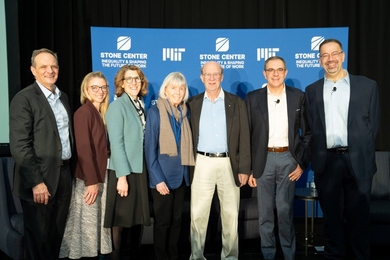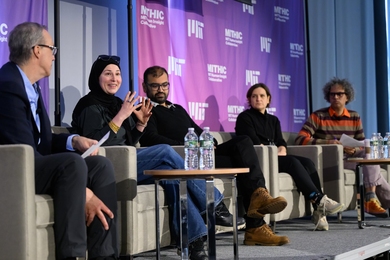Edwin C. (Jack) Whitehead, founder of the MIT-affiliated Whitehead Institute for Biomedical Research and a Life Member of the MIT Corporation, died Sunday, Feb. 2, after suffering a heart attack during a squash game. He was 72 and lived in Greenwich, Conn.
A memorial service is planned for 3pm Thursday, Feb. 13, at the New York Academy of Medicine, 2 East 103d Street, New York City, and in Cambridge at a date to be announced.
Remembrances may be made be The Jack Whitehead Memorial Fund through the Whitehead Institute.
Mr. Whitehead, a noted businessman, had a distinguished career in science, industry, medicine and philanthropy.
He was a co-founder in 1939, with his father, of Technicon Corporation, a pioneer in scientific and clinical instrumentation. What began in a one-room office in the Bronx grew over the next 40 years into a $450 million international corporation whose innovative products and technologies played a key role in creating the modern clinical diagnostics industry.
After the company's sale in 1980 in a stock and cash exchange in excess of $400 million, Mr. Whitehead fulfilled one of his lifetime goals with the founding of the Whitehead Institute, a nonprofit, independent basic research and teaching institution affiliated with MIT in its teaching activities but responsible for its own facilities and finances.
The affiliation was forged in 1982, with Mr. Whitehead providing $35 million to build the research facility in Kendall Square, adjacent to the MIT campus, and establishing a trust fund to provide annual operating expenses into perpetuity, for a total of about $135 million. It stands as the largest single gift ever made to American science and one of the largest made for any purpose, according to the Institute.
Dr. David Baltimore, an MIT professor of biology and Nobel laureate who helped develop the plan for the Whitehead Institute and its affiliation with MIT, was recruited as its founding director.
In its short history, the Institute has become one of the world's most prestigious and productive basic biological research institutes.
Today the Whitehead Institute houses approximately 320 scientists divided among 20 laboratories. Fifteen of the laboratories are under the direction of members or associate members, all of whom hold joint appointments on the MIT faculty in the Department of Biology; the other five laboratories are directed by Whitehead Institute Fellows. In addition, the Institute provides educational and research opportunities for about 65 graduate students, mostly from MIT, and some 40 undergraduates supported by the Undergraduate Research Opportunities Program. There are also postdoctoral fellows and visiting scientists from throughout the world.
At his death, Mr. Whitehead was chairman of Whitehead/Sterling, a private investment and asset management company in Stamford, Conn.
Although he had no official role at the Whitehead Institute, he visited often, took pleasure in the scientific achievements and worked with its board of trustees and administration.
Dr. Gerald Fink, the Institute's director, said that Mr. Whitehead's "vitality and enthusiasm for science were part of the spirit of the Whitehead Institute. He was a great philanthropist, but he gave us much more than his financial support. He took great joy in our achievements and was a constant source of encouragement. He envisioned a future in which biomedical science would contribute to the betterment of all human beings."
Mr. Whitehead, who held almost 20 patents covering fields from tissue processing to automated blood analysis, was the first and only non-PhD/MD to receive the Van Slyke award from the American Association of Clinical Chemists for his contributions to clinical chemistry and laboratory diagnostics.
He was a trustee and director of a number of foundations, organizations and universities.
He was elected a Life Member of the MIT Corporation in 1989 and served on the visiting committees for the Departments of Biology and Mechanical Engineering and the Whitaker College of Health Sciences and Technology.
MIT Chairman Paul E. Gray, who was MIT president at the time of the affiliation with Whitehead, said, "In his creation of the Whitehead Institute, Mr. Whitehead made a great and lasting contribution to the life sciences. The entire scientific community, and MIT particularly, are stronger because of his foresight and generosity."
Mr. Whitehead is survived by his three children, Susan of Wellesley, Mass., Peter of New York City and John of Dunwoody, Ga., and by numerous stepchildren and grandchildren.
A version of this article appeared in the February 5, 1992 issue of MIT Tech Talk (Volume 36, Number 19).





